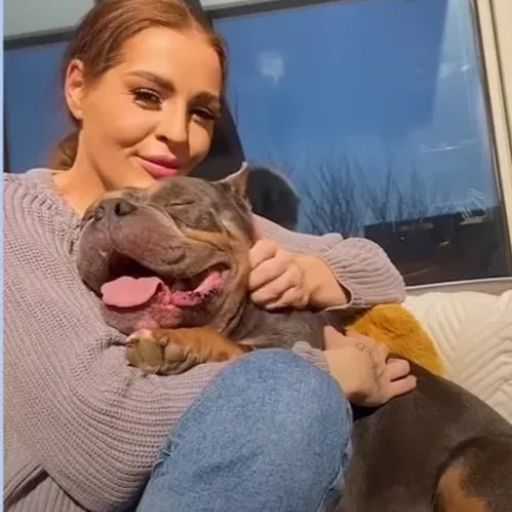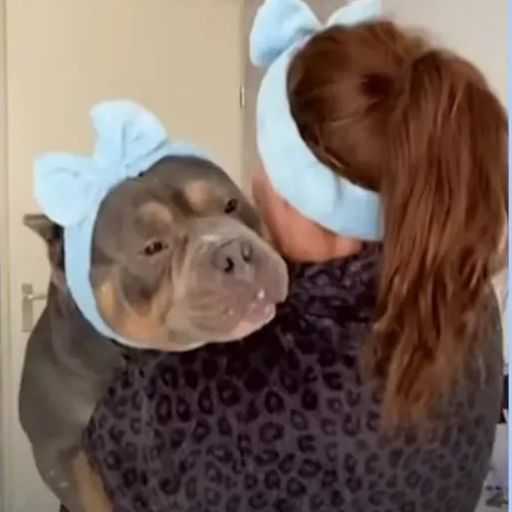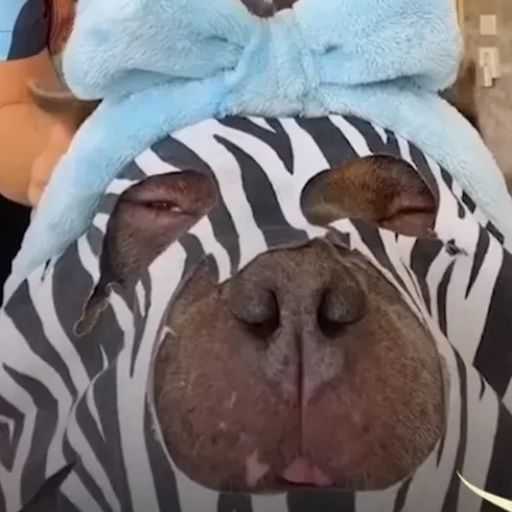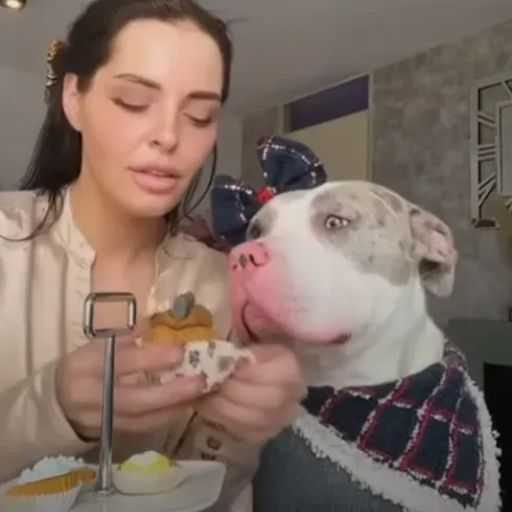Raffie, a pit bull with a coat the colour of worn leather, arrived at Sarah’s doorstep with a bundle of nervous energy. His eyes once filled with a playful glint, now held a deep-seated fear. Sarah, a woman grappling with her demons, knew all too well the marks life could leave on a soul. Raffie wasn’t just any rescue dog; he was a bait dog, a victim of cruelty that had left invisible scars etched deep within him.

The early days were a delicate dance. Sarah, with a heart overflowing with empathy, showered Raffie with patience and understanding. Gone were the forceful commands and harsh corrections he had come to expect. Instead, Sarah spoke in soft murmurs, offering gentle pats and quiet encouragement. Food, once a source of competition and anxiety, became a symbol of trust. As Raffie cautiously approached the bowl, Sarah’s heart swelled with quiet pride.

One evening, as Sarah sat on the floor, lost in thought, a low rumble emerged from Raffie’s chest. It wasn’t a growl, but a vibration, a sound that sent shivers down her spine. It was a purr, a sound more commonly associated with contented cats, yet here it was, emanating from the depths of a traumatized pit bull. At that moment, Sarah realized a connection had formed, a silent language of shared vulnerability and unspoken understanding.

They settled into a rhythm, a comforting routine that soothed the anxieties of both humans and dogs. Mornings began with a playful ritual. Sarah, clad in a fluffy bathrobe, would twirl around the living room, Raffie mimicking her movements with a clumsy dance of his own. His tail once held low, would wag tentatively, a sign of his growing trust.

Bath time, once a stressful ordeal, became a moment of bonding. Sarah would meticulously brush his fur, each stroke a silent apology for the cruelty he had endured. Despite having only one front tooth, a reminder of his past battles, Raffie would close his eyes and lean into her touch, a gesture of surrender and newfound trust.

Their days were filled with walks in the park, the sound of Sarah’s voice a constant reassurance to Raffie. The world, once a place of fear, became a canvas of new experiences. The scent of freshly cut grass, the playful banter of squirrels in the trees, the warmth of the sun on his fur – these simple pleasures brought a spark back to Raffie’s eyes.

As Raffie blossomed, Sarah’s burdens seemed to lighten. The companionship he offered was a balm to her soul. In caring for him, she found a renewed sense of purpose. They were healers for each other, two souls mending the cracks life had left behind.

Their little pack grew with the addition of Oden, a boisterous German Shepherd with a heart as big as his bark. Odin, unlike Raffie, greeted the world with boundless enthusiasm. Mealtimes with Odin were chaotic affairs, his food bowl disappearing in a whirlwind of happy chomps. Yet, a surprising camaraderie developed between the two dogs. Odin, with his playful energy, coaxed Raffie out of his shell, encouraging him to join in their backyard wrestling matches.

Cupcake, the youngest addition, was a whirlwind of fluffy fur and boundless puppy energy. The runt of the litter, she embodied the resilience of the small. Her, playfulness never faded her puppy-like enthusiasm an infectious joy that filled the house with laughter. Raffie, once wary of strangers, found himself drawn to Cupcake’s playful nips and clumsy attempts at wrestling. He became her patient mentor, teaching her the ropes of dog etiquette with gentle nudges and playful growls.

Their home transformed into a haven of unconditional love. Sarah, surrounded by her furry companions, found a solace she never thought possible. The weight of her past seemed lighter, replaced by the comforting weight of a furry head resting on her lap, the rhythmic thump of a tail against the floor, and the quiet symphony of snores emanating from a den of contented dogs.

Looking at her furry family, Sarah couldn’t help but smile. The scars they each bore, both visible and invisible, were a testament to their battles. Yet, in their shared space, they had found a place of healing, a reminder that love and companionship have the power to mend even the deepest wounds. They were a pack, bound not by blood, but by the invisible threads of empathy, understanding, and the unwavering loyalty that only love can forge.

Watch The Full Video Here:
If you’ve ever shared your life with a furry companion, you know that the bond between a dog and its human is truly special. Dogs have a way of filling our days with joy, laughter, and unconditional love. However, as a dog owner, there comes a time when you may find yourself contemplating the inevitable – the circle of life. Understanding the natural course of a dog’s life is part of being a responsible pet parent.
As a seasoned dog trainer, you’ve witnessed firsthand the unique connection that forms between dogs and their families. From puppyhood to their golden years, dogs bring companionship and loyalty like no other. While the thought of mortality may be difficult, it’s essential to have open conversations about the life cycle of our beloved canine friends.
Exploring the Concept of Dogs’ Mortality
Understanding the Lifespan of Dogs:
- Dogs’ lifespan varies based on their breed and size.
- Small breeds like Chihuahuas can live 15-17 years, while larger breeds like Great Danes have a shorter lifespan of 7-10 years.
- As a pet parent, it’s crucial to be aware of your dog’s life expectancy to provide appropriate care through different life stages.
Coping with the Loss of a Dog:
- Losing a furry companion is heartbreaking and can lead to grief similar to losing a family member.
- It’s essential to allow yourself to grieve and seek support from loved ones during this difficult time.
- Remembering the happy moments shared with your dog can help ease the pain of their absence.
Preparing for the Future:
- Consider creating lasting memories with your dog through photos, paw prints, or special keepsakes.
- Planning for end-of-life care, such as palliative care or hospice, can help ensure your dog’s comfort in their final days.
- Discussing euthanasia with your veterinarian if your dog is suffering and the quality of life is compromised is a compassionate decision.
Honoring Your Dog’s Memory:
- Celebrate your dog’s life by creating a tribute like a garden memorial or donating to a pet charity in their name.
- Sharing stories and memories of your dog with others can keep their spirit alive in your heart.
- Take the time you need to mourn and heal, knowing that your dog’s love will always remain with you.
Remember, facing the mortality of your beloved pet can be challenging, but by understanding, preparing, and honoring their memory, you can navigate this emotional journey with love and remembrance.
Understanding Common Beliefs and Myths
When it comes to dogs and their lifespans, there are various beliefs and myths that can cause confusion and uncertainty. Here, we address some common misconceptions and provide clarity on these topics:
Dogs Have Nine Lives Like Cats
Contrary to popular belief, dogs do not have nine lives like cats. Dogs have one life, just like any other living being. While dogs are often resilient and can recover from injuries or illnesses with proper care, they do not possess multiple lives.
Smaller Dogs Live Longer Than Larger Dogs
It’s a common belief that smaller dogs live longer than larger breeds. While size can influence a dog’s lifespan to some extent, it’s not a hard and fast rule. Factors such as genetics, overall health, and care play a significant role in determining a dog’s life expectancy, regardless of its size.
Human Years Equal Seven Dog Years
The idea that one dog year is equivalent to seven human years is a simplified way of estimating a dog’s age in human terms. However, this calculation is not entirely accurate for all stages of a dog’s life. Dogs age at different rates depending on their breed and size, so it’s essential to consider these factors when assessing their age.
All Dogs Are Affected by Common Myths
Not all dogs are impacted by the same beliefs and myths. Each dog is unique, and factors such as breed, health, and environment can influence how long they live and how they are perceived in terms of age and vitality.
Proper Care Can Extend a Dog’s Lifespan
While genetics and breed characteristics play a role in a dog’s lifespan, providing proper care, nutrition, exercise, and regular veterinary check-ups can significantly impact their longevity. By taking care of your furry companion’s well-being, you can help ensure they live a long and healthy life.
Understanding these common beliefs and myths about dogs can help debunk misconceptions and provide a clearer perspective on your canine companion’s life and well-being. Remember, each dog is unique, and by being informed and attentive, you can ensure a fulfilling and loving relationship with your loyal four-legged friend.
Factors Influencing Canine Lifespan
Genetics and Breed:
Genetics play a significant role in determining a dog’s lifespan. Different breeds have varying life expectancies based on their genetic makeup. For example, smaller breeds like Chihuahuas tend to live longer than larger breeds like Great Danes.
Nutrition and Diet:
Providing your dog with a balanced and nutritious diet is crucial for their overall health and longevity. A diet tailored to your dog’s specific needs can help prevent certain health issues and support a healthy lifespan.
Exercise and Activity Level:
Regular exercise is essential for keeping your dog physically and mentally healthy. Dogs that engage in daily activities tend to live longer and have a higher quality of life than those who lead sedentary lifestyles.
Veterinary Care:
Routine check-ups and preventative care from a veterinarian can help detect any underlying health issues early on, leading to prompt treatment and potentially extending your dog’s lifespan.
Environment and Living Conditions:
A safe and comfortable living environment is vital for your dog’s well-being. Providing a stress-free and enriched environment can contribute to your dog’s longevity and overall happiness.
Love and Companionship:
Dogs thrive on love and companionship. Building a strong bond with your furry friend, offering affection, and ensuring they feel secure can positively impact their lifespan and quality of life.
Genetics, Nutrition, Exercise, Vet Care, Environment, Companionship:
By focusing on these key factors, you can help promote a long and healthy life for your beloved canine companion. Providing them with the care and attention they need can ensure a fulfilling and loving relationship for years to come.
Coping with the Loss of a Canine Companion
Losing a pet can be incredibly challenging. It’s normal to feel a range of emotions when you lose a furry friend. Remember, it’s okay to grieve. Here are some ways to cope during this difficult time:
- Allow Yourself to Grieve
It’s important to acknowledge your feelings. Cry if you need to. Don’t be afraid to seek support from friends or family members. - Create a Memorial
Consider creating a special tribute to your beloved dog. Plant a tree, make a scrapbook, or create a photo album to honor your pet’s memory. - Keep a Routine
Maintaining a routine can help you cope with the loss. Stick to regular mealtimes and walks if you had a daily routine with your dog. - Seek Support
Reach out to support groups or a therapist specializing in pet loss if you’re struggling to cope. Talking to others who have experienced a similar loss can be comforting. - Take Care of Yourself
Remember to take care of yourself during this challenging time. Get plenty of rest, eat well, and engage in activities that bring you comfort. - Consider a New Pet
While it may be too soon for some, adopting a new pet can bring joy back into your life. However, never try to replace your previous pet; each pet is unique.
Losing a pet is never easy, but with time and support, you’ll learn to cherish the memories you shared with your canine companion.
Conclusion
Losing a dog is never easy, but it’s a natural part of the journey we share with our furry friends. Remember, it’s okay to grieve and cherish the memories you’ve created together. Creating a special memorial can help honor your beloved companion. Keeping routines and seeking support from loved ones are essential during this time. Taking care of yourself is crucial as you navigate through the loss. And when you’re ready, opening your heart to a new furry friend can bring new joy while still treasuring the moments with your previous dog. Cherish the paw prints they left on your heart.
Frequently Asked Questions
What is the article about?
The article explores the special bond between dogs and their human companions, detailing the joy, responsibilities, and unique connection throughout a dog’s life stages.
Does the article discuss a dog’s life cycle?
Yes, the article addresses understanding a dog’s life cycle, debunking myths about their lifespan, and highlighting the importance of proper care for longevity.
How does the article suggest coping with the loss of a canine companion?
The article emphasizes the normality of grieving, creating memorials, maintaining routines, seeking support, practicing self-care, and considering the option of adopting a new pet while honoring memories of the previous dog.

Hey there, I’m Janet Brooks, a dog-loving student from California. I’m all about helping pups in need, especially those without homes. Me and my awesome friends work together to give shelter and love to stray dogs. Oh, and I also write blogs about dogs to share helpful info.